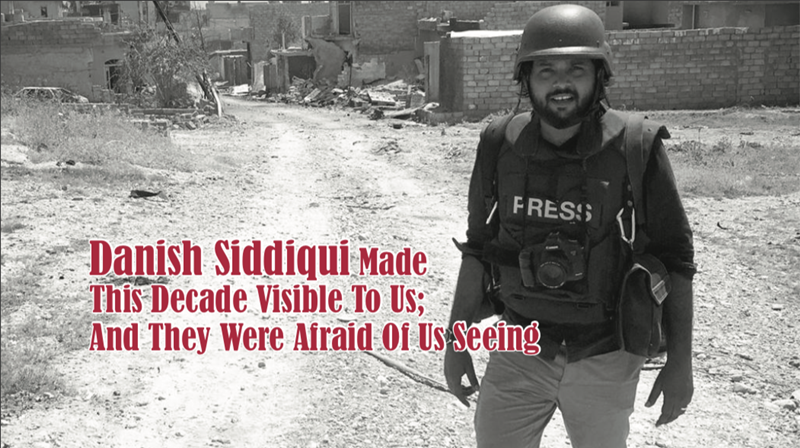He saw an awful lot of things. What happens to a person committed to seeing realities, and helps others to see the same. Danish Siddiqui is a case study.
SAJI P MATHEW OFM
He began not knowing that he was beginning. He began with a borrowed camera, and black and white rolls bought with his pocket money; he just captured images around him, clicked pictures during his school trips. He was unaware of what was coming; but he definitely had an eye for seeing. He wanted to tell stories. He enrolled in a film school, made good use of the photography classes. Worked as a television journalist with a news television network. He saw his calling in photojournalism. Apart from the initial inputs in college, he was mostly self-taught. He took risks, kept experimenting; and finally he had arrived. He kept going places with the best of photographers in the field. World journalism got a brave, fearless son –Danish Siddiqui.
Every child does not have the same undeterred path to destiny, ‘I was more fortunate’, he seems to suggest with his images of Rubina. It was an assignment that has left the biggest mark on him. Rubina, the child star of the film “Slumdog Millionaire”, had her shanty in a slum colony gutted by fire. May be the English idiom, ‘from frying pan to fire’ was coined for her. Danish photographed her literally on the streets. She had sunk from her shanty to the street. Danish highlighted the little girl’s courage and grit. She had lost everything in one night, including the precious photographs from the Academy Award’s evening in Los Angeles, where she had walked the red carpet with her co-actors. She still had her hope and determination intact. Perhaps the face of that little girl must have sustained Danish even through terrains of fierce battle. Having two children himself, he also knew the pain of seeing children ending up on streets.
Siddiqui the Sensitive Storyteller
For Siddiqui every picture was a story unfolding. He said, “As Photojournalists you want to just take that picture which tells the whole story, because you just have one frame to tell the whole story.” He admits in his Ted talk, “As a photojournalist I have the privilege to witness humanity at its best and at its worst and everything in between. My role is as a mirror; and I want to expose you to the raw truth and make you a witness to it. You can look away, or stand up for change.” While Siddiqui enjoyed covering news stories from business to politics to sports, what he enjoyed most is capturing the human face of a breaking story. He said, “I really like covering issues that affect people as the result of different kind of conflicts.”
Siddiqui respects his subjects. They inspire him. In telling these stories though photo- graphs, Siddiqui faced technical challenges and emotional challenges. Technical challenge is to showcase the story in a dignified way. In the context of covering Pandemic in India he says, “We don’t go too close so that the dignity of the family and victim is maintained. But there is the challenge of showing the scale of devastation of this pandemic happening in the heart of the country.
Rohingyas and the Pulitzer
In 2017 more than 7,00,000 Rohingya Muslims had to take on a dangerous journey to escape persecution in their homeland Myanmar. Thou- sands died in their pursuit to Bangladesh. Some survived only to face worse treatments in refugee camps. Siddiqui was part of the Reuters photography team for documenting the Rohingya refugee crisis. He received the 2018 Pulitzer Prize for Feature Photography, as part of the Reuters team, for documenting the Rohingya Refugee Crisis. The judging committee described the series as “shocking photographs that exposed the world to the violence Rohingya refugees faced in fleeing Myanmar”.
Commending on the Pulitzer Prize, Siddiqui said, Photographs really helped highlight the plight (of Rohingya refugees), as a photojournalist you need to capture everything in one frame. In that picture you can see the plume of smoke, the boat, the refugees. All the elements were there to tell the story.
They were afraid of us seeing
Danish Siddiqui hurried across distances through terrains made difficult by conflict, political apathy, and partisan agenda. He travelled across borders and barbed wires. He reached every place of happening. He saw an awful lot of things.
He walked through the cities of India before and after the Acha Din promises. He saw slums. He saw people in the grips of poverty. He saw
the Kumbh Mela. He saw sponsored religious celebrations that furthered the partisan agenda. He saw Queer Azaadi. He saw the hapless pile
of Rohingya refugees drifting along the unwelcome Bangladeshi shores. He saw protests and suppression in Kashmir following the scrapping of its special constitutional status by Indian government in 2019. He saw power actions in North Korea in 2018. He saw wars and conflicts from Iraq to Afghanistan. He saw protests in Hong Kong, and earthquake in Nepal. He saw the CAA protests. He saw political apathy during the waves of Coronavirus Pandemic in India.
He not only saw them; his camera captured them and the media brought it alive to our living rooms though media online and offline. In the words of Danish Siddiqui, “While I enjoy covering news stories -from business to politics to sports - what I enjoy most is capturing the human face of a breaking story, I shoot for the common man who wants to see and feel a story from a place where he can’t be present himself.”
∎